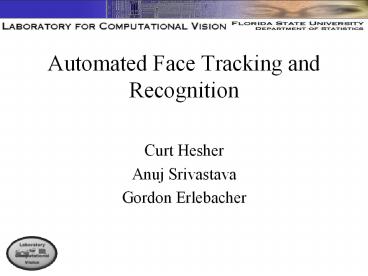Automated Face Tracking and Recognition - PowerPoint PPT Presentation
Title:
Automated Face Tracking and Recognition
Description:
Automated Face Tracking and Recognition Curt Hesher Anuj Srivastava Gordon Erlebacher Overview Review of Past Research in Face Tracking and Recognition Data ... – PowerPoint PPT presentation
Number of Views:272
Avg rating:3.0/5.0
Title: Automated Face Tracking and Recognition
1
Automated Face Tracking and Recognition
- Curt Hesher
- Anuj Srivastava
- Gordon Erlebacher
2
Overview
- Review of Past Research in Face Tracking and
Recognition - Data Acquisition and Representation
- Face Tracking Using Images Generated from
Geometry - Face Recognition Using Range Images
- Conclusions and future work.
3
A Review of Face Tracking and Recognition
- Survey papers
- Past research
- Commercial implementations
- Persistent challenges
4
Survey Papers
- Nonconnectionist (Samal and Iyengar) Approaches
dealing with the relative position of feature
points (distance between eyes, corners of the
mouth, etc.) derived from certain pixel values - Connectionist (Valentin et al.) Approaches that
derive characteristics from the whole face image
(i.e., PCA) - General (Chellappa et al., Barrett, Zhao et al.)
Approaches categorized as neural, statistical,
and feature based
5
Past Research
- Start with 2D images
- LDA, KDA, PCA, SVM, EBGM
- Neural, statistical, feature analysis
6
Commercial Implementations
- Numerous implementations
- Statistical, neural, and feature based
- Government sponsored tests (FRVT 2000 and 2002)
show accuracy between 20 and 90 depending on
the environment - Robust face recognition is still unsolved
7
Persistent Challenges
- Variation from pose
- Variation from lighting
- Occlusions
- Poor image quality
- Techniques beginning with 2D data have been
heavily researched. A new imaging modality
should be researched 3D Imaging
8
A Novel Approach
- Start with 3D data
- Use the additional information present in 3D data
for tracking and recognition
9
Data Acquisition and Representation
- Minolta Vivid 700 3D scanner
- Meshes captured using 3D camera
- ½ second capture time
- Subject motion avoided
- Light independent data capture of geometry
10
Data Acquisition and Representation
- Sample points on the surface of an object and
connect them via lines to form a mesh
- 200x200 geometry res.
- 400x400 texture res.
- About 10K points sampled from a face
- About 40K pixels sampled from a face
11
Tracking
- Algorithm
- Experiment
- Conclusions
12
Algorithm
13
Algorithm
- Segmentation and recognition are not addressed
- Mesh is manually chosen
- Video is manually chosen (subject is face forward
in the first frame and at a reasonable distance
from the camera)
14
Algorithm
- Tracking through synthesis
- Cost function (C) indicates likeness of estimate
(E) to target (T) - Follow the gradient of the cost function to
achieve alignment
15
Experiment
- Synthetic and real target video
- Synthetic target initially used to avoid nuisance
variables (i.e., lighting, noise, etc.) - Parameters for tracking are chosen manually and
refined by observation - (add video tracking example)
- Successfully tracks around 20 to 50 frames before
failing
16
Experiment
- Successfully tracks around 20 to 50 frames before
failing
17
Conclusions
- Does not handle background clutter
- Does not handle lighting variations
- Computationally expensive
18
Principle Component Analysis of Range Images for
Face Recognition
19
Facial Identification
- Many current modalities of investigation
(intra-feature distance, geometrical
parameterization, reflectance) - Outstanding issues in previous modalities
(reflectance, orientation) - New modality, Range Imaging.
20
What are Range Images
- Range Images are generated from a mesh
- Meshes captured using Minolta Vivid 700 3D camera
21
Data Collected
- 115 persons
- 6 facial expressions per person
- 690 3D facial images
- Subset of 37 persons under 6 expressions used in
current experiment - Some manual correction to data (hole patching)
22
Range Image Generation
- Traverse each triangle in the mesh
- Orthographically project depth values onto the
range image plane
23
Range Image Registration
Automatic Preprocessing
- Orientation rotation in the image plane
- Translation translation in the image plane
- Depth translation perpendicular to the image
plane
24
Recognition using Range Images
- Training data a subset of the experimental data
set is used to learn the variability in facial
range images - Testing data remaining faces used in attempted
recognition - Dimension reduction Principle Component
Analysis (PCA) used to reduce facial range images
to 10 dimensional vectors
25
Dimension Reduction
- Twenty largest Eigen values (above)
- Three Eigen vectors from three largest Eigen
values (right)
26
Testing Nearest Neighbor Algorithm
- Use the Euclidian distance between coefficients
(projection of the image in dominant subspace
first ten Eigen vectors) - Nearest neighbor (image from training set with
most similar projection) chosen as match
27
Identification Results
- Correct identification
28
Identification Results
- Incorrect identification
29
Identification Results
- Incorrect identification
1.109634e02 1.295154e02 1.366959e02 1.147805e02 1.636073e02 1.383662e02
30
Identification Results
Training Faces
31
Future Research
- Other projection techniques (Fisher
Discrimination Method) - Joint recognition using range and texture images

